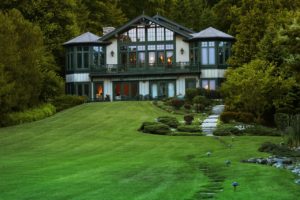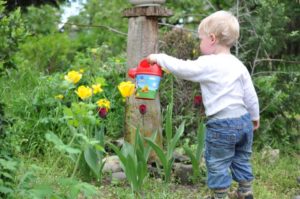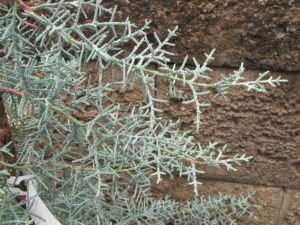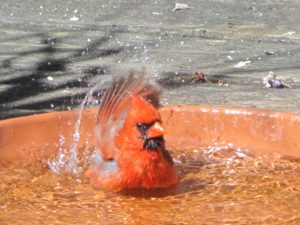A Landscape Primer
Now that you and your family have enjoyed a few months of outdoor activities, you’ve noticed a few changes you’d like to make. Summer is a good time to start thinking about improving the landscape, but many gardeners wait until the cooler days of early autumn before starting the work. The weather at that time is more favorable for establishing most plants than it is during the hot—and often dry—conditions of summer.
This is not to say that you can’t successfully plant at other times of the year. With careful maintenance, plants will survive a summer installation.
Before the first time a shovel goes into the ground, get the underground utilities and cables marked. Call your municipal authorities (8-1-1, in the U.S.) to have it done.

A fine example of framing the house.
Check All That Apply
- Is the patio too small for family gatherings?
- Are you tired of spending your weekends pruning shrubs?
- Are you putting your house on the market within a few years?
- Does retirement allow more time for vegetable gardening?
- Is it time for the greenhouse you’ve always wanted?
- Where will I put the cold frame the kids gave me last Christmas?
- Now that the trees are mature, is it time to get rid of the struggling lawn (and the mower)?
- Are the children showing an interest in butterfly gardening or a goldfish pond? Are you?
Walk around the property, clipboard in hand, and note all the issues that need improvement. Go ahead; dream a little! Start to visualize how you could use different areas of the property.
A Little Research
Visit public gardens and parks at different times of the year, taking notes and pictures. Notice how the interplay among trees, shrubs, ground covers, flowering plants, and structures creates a harmonious picture. Don’t ignore how you got from point A to point B; pathways are practical and are among the most important features of the landscape.
Books, magazines, online sites, and classes offered by Master Gardeners’ programs and community colleges are excellent sources of information. Record the names of plants you can’t live without as well as those that do nothing for you. And get all the information, so you can avoid asking, after the planting, “What did I ever see in you?”
Take a look at the trees, shrubs, and flowering plants offered by your local garden centers, and ask about winter hardiness and susceptibility to disease and insects. Find out what they do in every season of the year, what kind of maintenance they require, and how they can contribute to improving the landscape.
If low maintenance is important, look for dwarf varieties of plants that don’t need to be sheared every other month. Copy the full name of the plant: the botanical name (Genus and specific epithet), the ‘Cultivar’, and the common name. Then research them. “Japonica”, “Holly” and “White Splendor” refer to dozens of plants!
In the spring, and sometimes in the fall, landscape contractors set up full-size exhibits at home and garden shows. See which displays appeal to you the most. Personnel are available to answer questions and to set up consultations, but first find out how they will be compensated.
Compile a list of likes and dislikes (colors, materials, styles), which will guide the designer (or you!) in planning a garden that will give you the greatest pleasure. Decide what’s realistic financially and in terms of time and effort required to maintain your project.
Using Native Plants When Improving the Landscape
Plants that are native to your area adapt more readily to local environmental conditions. Seasonal temperatures, precipitation, and soil composition are a few factors that contribute to a species’ evolution. So, if the sourwood tree (Oxydendrum arboreum) evolved in the Carolinas, then the one planted in a North Carolina garden is likely to survive without being pampered.
Plant breeders have introduced “new and improved” versions that you might find more appealing than the original species. Cultivars of trees, shrubs, and perennials native to a region are available in a wide variety of plant heights or foliage and flower colors. Look for these “nativars” at your local garden centers.
If you want to attract more butterflies to your garden, find out which plants will feed the larval stage of a particular insect. Many species of butterflies have declined significantly in numbers, and it’s up to us gardeners to make an attempt at reversing that trend. Remember that insects, birds, and other animals evolved alongside a unique set of plant species, and that they’re all interdependent for long-term survival. If holes in the leaves bug you, perhaps confining those unsprayed plants to the back yard is a good compromise.
My mother and I enjoy watching the northern cardinals and other birds visiting the bird feeders. To make them feel at home in your garden, incorporate shrubbery that provides nesting opportunities and shelter. And don’t forget the bird bath! There’s nothing like a beautiful cardinal to enliven a winter landscape.
Speaking of shelter, consider constructing a simple brush pile to protect overwintering insects and other small animals. All that garden debris hauled off to the recycling center includes many insects in their pupal stage. Keeping cocoons and chrysalises on your property will ensure greater numbers of butterflies and other insects that might feed the next brood of bluebirds or wrens.
Leave It To the Professionals
Perhaps the scope of this kind of work is beyond your comfort zone and you’d rather employ a landscaper to install it. If you hire a contractor, try to accommodate him or her by confining the family pets, removing children’s toys, and providing easy access for the workers.
Improving the landscape and transforming it from blah to beautiful requires a fair amount of disruption. Expect dust, mud, noise, and possible delays.
Identify existing plants that are special to you and ask the contractor early in the process if they can be worked into the plan. Some might be too large and unlikely to survive the transplant. Dig up dormant bulbs, if you can find them, and replant later in areas suggested by the designer.
If you’re an experienced gardener or an avid beginner, you might wish to participate in some aspects of the project. Maybe you’d prefer to have the contractor deal with permits, inspections, hardscape (utilities, paths, structures), and large specimens, while you plant the annuals, vegetables, and bulbs. All details should be spelled out in the contract. Open communication prevents most misunderstandings.
You might prefer to have the first phase installed this year, with additions made over the next few years. Ask the contractor which parts should go in first.
Headings
Page 1: A Landscape Primer, Check All That Apply, A Little Research (Using Native Plants When Improving the Landscape), Leave It To the Professionals
Page 2: Design Considerations For Improving the Landscape (The Right Size, Getting the Picture, But I’m Repeating Myself, One Garden in Derwood, Add Some Rocks), Improving Curb Appeal (Under the Parrotia Tree (Surprise!), Raise It Up, Only the Beginning



